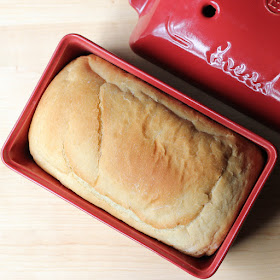 You might have noticed that I have a lot of bread recipes over on Cookistry. And I wrote a bread-baking cookbook. I'm always experimenting with recipes, and with equipment.
You might have noticed that I have a lot of bread recipes over on Cookistry. And I wrote a bread-baking cookbook. I'm always experimenting with recipes, and with equipment.The Emile Henry Loaf Baker
If you've baked a lot of bread, you've probably noticed that it makes a difference what you bake the bread on - or in. Different materials have different heating properties - some heat faster, others heat slower. Some are better at transferring heat. And there are other differences.
What that means is that bread baked on a cookie sheet will react differently than one baked on a baking stone.
 So, the Loaf Baker offers a much different baking experience than a standard metal baking pan. Not only is it a completely different material, but it also has a cover, which means the bread is baked in a much moister environment than in an open oven.
So, the Loaf Baker offers a much different baking experience than a standard metal baking pan. Not only is it a completely different material, but it also has a cover, which means the bread is baked in a much moister environment than in an open oven.That moist environment results in a crisp crust - it's why some bread recipes suggest that you spritz water into the oven or have a pan of water in the bottom of the oven. The idea is to create a steamy environment for the baking bread.
But with an enclosed pan, you don't need to create steam - the bread itself gives off moisture, and that moisture gets trapped inside the pan. So you have the advantage of steam with less fuss.
 I hesitate to say that one pan or one material is better than another. It depends a little bit on what your desired result is.
I hesitate to say that one pan or one material is better than another. It depends a little bit on what your desired result is.But I'm all about choices. I love having different pans to use, and the Emile Henry Loaf Baker is definitely worth adding to the baking arsenal. It's different from other pans that I own, and ... it's not just utilitarian. It's pretty. It would look good displayed on a shelf when not in use.
I think the lid is a major reason why this pan is appealing, but you can also use the pan without the lid, just like a regular baking pan.
I've used it for basic white bread and rye bread, but I'm sure you'll be seeing it on Cookistry for some more recipes I've been working on!
 Who's it for: People who bake bread and want options besides basic metal bread pans.
Who's it for: People who bake bread and want options besides basic metal bread pans.Pros: Useful and attractive.
Cons: Since it's ceramic, it needs a little more care than a metal pan that you can drop without causing major damage.
Wishes: I wish I would have had this years ago.
Source: I received this from the manufacturer for the purpose of a review.

































